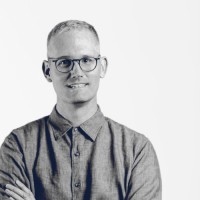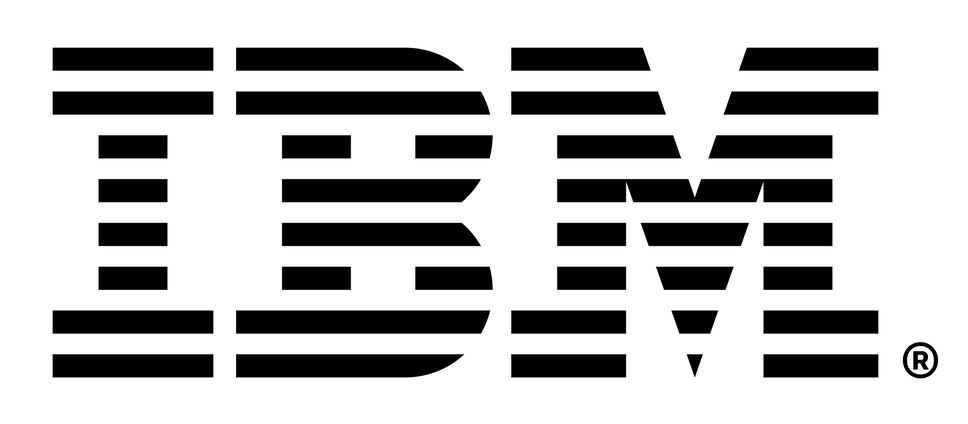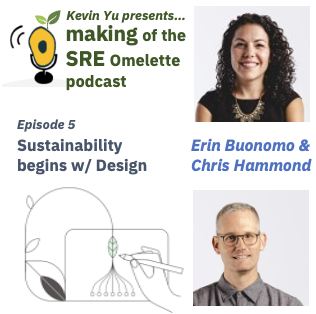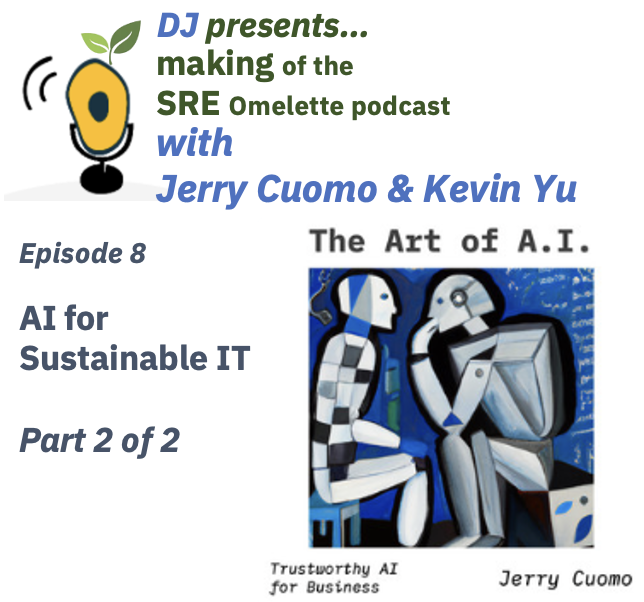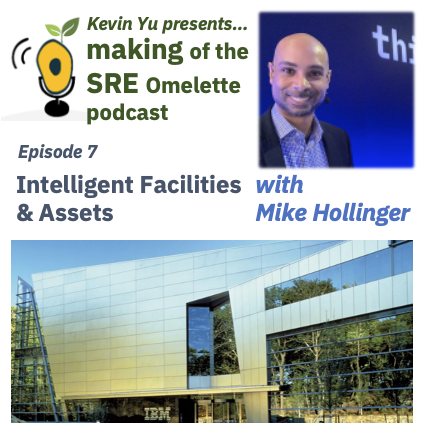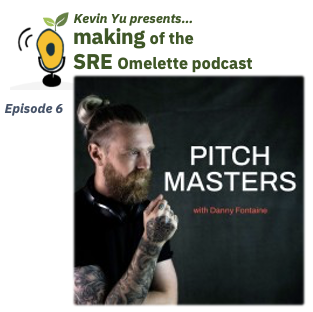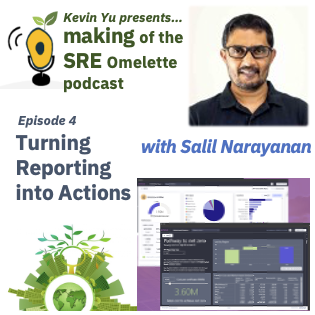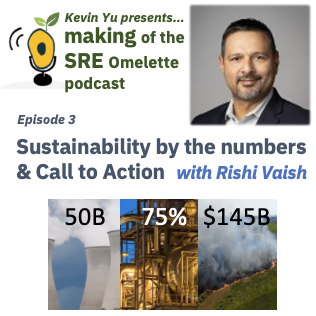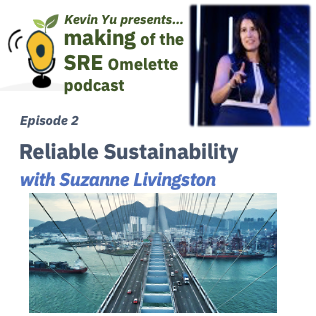Episode 5 - Sustainability begins with Design
- 0.5
- 1
- 1.25
- 1.5
- 1.75
- 2
Chris: High- performance operations equal high- performance sustainability. As you think about that call to action for the SRE community, like you should liberally steal and borrow that, right? How might we develop sustainability consciousness across the SRE community?
Erin: Diversity of thought and perspectives is critical to our day- to- day solutioning. We always come up with better solutions when we have different perspectives in the room. How do we have more visible SRE contributors early on in the process and attending design and technical reviews? Be curious and ask those hard questions.
Kevin: Hi everyone. Welcome back to another episode of Making up the SRE Upland podcast where we'll talk about how we achieve business and client success via the practice of site reliability engineering. Season two is all about how the practice of SRE can help and lead us to a more sustainable future. Sustainability has become an important topic for companies and organizations, however, it is still very much a point- in- time discussion. Here to talk about how we can drive innovation and accelerate our pass to a sustainable future by starting the conversation with design is Irene Bunomo and Chris Hammett. Irene, Chris, welcome to the show.
Erin: Thank you for having us. We're very excited to be here.
Chris: Yeah, thanks Kevin. It's good to be here.
Kevin: Can you give the audience an intro of your roles to get us started?
Erin: Sure, I'll kick it off. I am the director of design for our sustainability software solutions where we're focused on designing solutions to help companies with their ESG data goals and strategy as well as environmental intelligence and asset management. I've been at IBM for about 20 years and I've held positions in engineering, product management, so I've been really focused on roles across enterprise software and I'm a trained software engineer, but it's been many moons since I've actually touched any code and I found my way into design about seven years ago and really haven't looked back. It's a great role to have because it plays a critical role within our company in transforming the human experience with technology.
Kevin: I remember working with you many moons ago when we were both working on our commerce solutions. Time flies. How about you Chris?
Chris: I'm a distinguished designer, so I'm a technical leader here at IBM. My mission is focused on defining user experiences that enable sustainability, and I think it's important, especially for this audience of SRE that when we say the word design, design is easily confused, but in the context for Erin and myself, design means focused on user experience design. Think about desirability, usability, IT architect, or an SRE, obviously focused on design and design is part of the verbs that they utilize, but a little bit different than desirability and usability. And I joined IBM in 2015 and I came from a very small boutique design and innovation firm. Before we get started, Kevin, quick question for you, in any place, this user experience design is pretty far away from site reliability engineering, so I'm curious why invite design to this conversation?
Kevin: Wow. I never have this happen so early in the show for someone and I love it. I think it is always important to start a conversation understanding why we're here. And the reason why I invited design to this dialogue is exactly what you said there, Chris. Typically, user experience design is pretty far away from SRE and I like to change that. I'll tell you a story that I experienced earlier this year and it really led me to have many conversation like this to get design involved. I was in a playback session where the team was demonstrating a new alert notification they built. First of all, there were PowerPoints of architecture, the flow, the code, the geeky stuff, and the demo. It all worked as intended and we showed that we can alert to a Slack channel when latency increased. Woo hoo, it was great. I did not ask a question, how often do we expect this alert to get triggered? And Chris, it was followed by silence. And finally some SREs spoke up that it'll be quite often. I thought it was a question, okay, who do we expect to be watching that channel all the time? And again, as we expected, silence. And this is a kicker, right? The SRE was the intended user for the alert, but we did not take the time to discuss with them how they like this experience to be. You get the point. I can go on and have many more stories like that.
Chris: Oh, that's great Kevin. Thanks for sharing with us. And I would just a shout- out to you, I know for myself and Erin, we've interacted with you and Ron and other of our SRE colleagues and it's great to see those connections between user experience and day- to- day operations.
Kevin: Thank you Chris and ditto here as well. So hopefully that story didn't scare you and you guys still willing to sit down with me. You two were the first to ask a question right off the bat and also the first designers on the season. I'm curious, what does sustainability mean to you from the design perspective?
Chris: I love that question, Kevin, and that's not an uncommon question. We get that a lot from different clients, from analysts, everybody wants to know how does sustainability enter into the way we design here at IBM. Facilitate that dialogue in those conversations, we released a position paper earlier in this year and it's called IBM Design for Sustainability. And I believe actually that Susanna referenced a similar paper on the engineering side that was released about the same time. But so for us as designers here at IBM, we define sustainability as bringing prosperity to all people, communities, and the planet both now and the future. And if we unroll that just a little bit, right? So there's a positive impact of sustainability and it includes all living things, not just humans. And we also want to consider how do we reduce our impact on the limited resources of our planet? And this definition that's in the position paper, it really does reflect design at IBM, whether that be in product design like Erin and myself or whether that be in consulting and even within our operations. You'll notice if you're familiar with the UN's sustainability development goals, there's a lot of overlap there. And we see how the UN has defined sustainability. There's significant overlap for what designers have been practicing for decades, which is often called human- centered design or user- centered design. And so as designers, it's important for us to zoom out, really understand the context of our user or the human that we're designing for. And what's really great about sustainability is it expands the scope of that context. We can't just design for a single human, not that we ever do that at IBM. There's typically a whole team. We've got a whole bunch of different personas and they're working together. But even if we look at that team and the people that are trying to create value with the software that we're designing, that's not enough. We need to consider the impacts of other people both in the community and around the world. We also need to consider the resources required to deliver that experience both today and in the future. So one of the things that I like to say is human- centered design is dead, but long- live life- centered design.
Erin: That's really well said. I love that statement and the passion around that. And I would say as designers working at IBM, we are, and I mentioned this before, we're leading product design for enterprise software that we are creating to enable companies around the world in different industries really take that and be able to leapfrog and accelerate and operationalize their sustainability ambitions. So we take this mission that we have as designers and team members, product team members, really seriously because we know that we have the opportunity to impact human experiences to be able to do amazing things for this planet. So I think in one of the things that we also, what it means to us, something on a day- to- day basis, because every day our decisions being made as we're creating solutions to problems. We're looking at how we leverage technology and human experience to enable these companies to be part of this broader sustainability transformation. So it's really an interesting and very fulfilling mission that we take day to day as part of our role. I mean, we are one discipline within a broader team enabling us to be able to make hopefully significant changes and help support those broader goals that we have. So it's really an exciting, good time to be a designer, exciting time to be a designer within IBM and within just the technology community with other companies as well that are focused on similar missions.
Kevin: Hear, hear, agreed, amazing time we're at to make inaudible impact and shifting from human- centered design to life- centered design, leaving the world in a better place than we found it. Erin, Chris, I want us to talk about that great future work where you think we should be doing shortly. Meanwhile, can you take the audience through what the process looks like today first?
Erin: It's interesting. This whole concept of sustainability honestly is very much a design challenge. And we live for complex design challenges. And what we often overlook is that 80% of a product's environmental impact influenced by decisions made at this stage of the process, the design stage, and decisions we make influence how long something lasts, what it's made out of, if it can be repaired or not, what happens to it at the end of life. So it's really critically important to look at what our processes today and figure out making sure we're making the right decisions earlier on in the process. And when we think about how we work every day at IBM, we are solving some really complex problems and we have to take various different elements into consideration when we're making decisions. We have to take into account whether we're making something that humans actually desire and need. We need to take into account the technical feasibility of the solutions that we are creating. We need to take into account the viability of the solutions that we're creating to our business. Obviously, we're a business as well, we're trying to make revenue off of the solutions that we're creating. So there's a lot of trade- offs that we have to make throughout just the process from the exception of an idea all the way into the implementation of that idea. We also need to take into consideration the sustainable impact of these ideas. So there's really a new fourth dimension that we need to ensure that we're evaluating earlier on in our ideation phase during that time where we're being creative and trying to find solutions and making sure we're consciously spending enough time considering this dimension and making intentional decisions so that we understand the environmental impact, we understand the social impact, et cetera. So just to make that real, giving you an example of what that actually looks like, if we're designing and architecting and building software, we need to make sure that it's efficient and reliable to run over time so that we minimize waste. And there needs to be these conversations that were happening on a regular basis earlier on in those ideation and design work shopping sessions. We need to be thinking about whether we're reporting on the resource utilization and the different processes that we use to maintain and run our systems and be able to talk about whether they're inefficient at these team meetings as a collective team and really be bringing data and insights back into our product process so that we can make improvements and enhancements to our existing software that we're creating. We have to ensure we have the right people in the room to be able to ask the right questions, and we need to make sure we're holding ourselves accountable and have the right metrics. So I would say as is, we already have an established product design process, for example, but we need to make sure we're having those intentional conversations earlier on in the process. I do think that there's opportunity to improve that in many ways.
Chris: Kevin, I want to highlight something that Erin just said. She talked about innovation and the framework that we all know and love. Is it desirable? That's where design comes in. Is it feasible engineering? Is it viable? Are people willing to spend money on this? Those aren't new concepts. But as Erin said, are we being intentional across those dimensions to really understand the sustainable impact of those decisions? The decisions we're making around desirability, around feasibility, around viability, that idea of evaluating sustainability across those dimensions, I don't know that it's very pervasive yet, but we're starting to see change as everybody becomes more and more aware of those. And I think as designers, as SRE, as product, as marketing, regardless of the role, are we relentless in making that solution both efficient for the users as well as the system that delivers it? I think if we're thinking about as is SASE environments, the Cloud, it kind of makes us lazy, right? Air quotes, we have infinite compute and storage and network, right? There is no... This idea of getting it to fit on a CD or a DVD or I'm old enough to remember floppy disks. We don't care because, well, I'll just add more compute, I'll add more storage. And I think the countermeasure for us is really how do we simplify the experience because it'll take our user, the person that's actually creating that value less time, but it's also going to reduce the energy requirements. So then it's kind of a triple win. It's good for the business because it's cheaper for us to deliver, that impacts our bottom line. It's good for the environment because we're minimizing our energy and carbon footprint. And it's good for people, meaning it's accessible to a broader sense of users. It's not just people who have the latest and greatest hardware and the fastest internet. There's a quote by one of my favorite authors, Antoine de Saint- Exupéry, he's well known for writing the Petit Prince or the Little Prince. He said, " Design is done not when there's anything left to add, but when there's nothing left to take away." And I think as it relates to operations, as it relates to user experience, as it relates to sustainability, kind of full stop. Are we just adding things or are we being very intentional about taking things away? I always think about that. When was the last time your listeners or yourself for that matter, when was the last time we were on a product project or product team and we also identified outcomes and key results or OKRs that speak to sustainability? And then, Kevin, for you especially in your audience as SRE, you have a significant impact on operations. The rhetorical question I think here is when was the last time that your voice was captured in the concept base? Like I said, rhetorical question, we don't have to answer that. Something to think about.
Kevin: Maybe this would alluded to, I do not think we SRE have a seat at the concept phase and it's not often. YouTube captured lots of what now seems like common sense dialogues to have. So what can we do differently to start having those conversations early?
Chris: Yeah. It's such a great question Kevin, and I'm going to quote our collective boss's boss. I can't take credit for this, but Kareem Youssef and I were having a conversation a year or so ago, and he mentioned sustainability consciousness, especially in the context of design. And I love that. And every time there's an opportunity to use it because I think it is very apropos for this question. And the way I define sustainability consciousness is, hey, every day, and I don't care if you're a designer, I don't care if you're an architect, I don't care if you're just writing code, but you're making decisions every single day about the design, about the implementation. And are we considering the sustainability impact? One of the things that we noticed when we were crafting the position paper on design for sustainability is that there are lots of things that we do or should be doing as designers in service of good design or great user experience that are inherently sustainable. And for example, if we think about accessibility, like our experiences, our products, regardless of our ability or lack of ability, are we able to use that create value there? And across IBM, especially within the design community accessibility, there's a strong foundational understanding there. It's definitely part of any education or training when somebody first joins IBM. And so we have a sense of what that means when we're designing the user experience or the user interface back to sustainability consciousness. But do we understand the contribution of the work we're doing in service accessibility as it relates to the sustainability posture of that product in our company? And to be very, very specific, like best practices from an accessibility perspective says if you have to have a video, don't have it autoplay, the user should be able to engage that. You should also provide captions in case somebody's visually impaired. And if we think about collectively, if we think about the number of videos across the internet and we'd like to use videos to help people get started with that experience, but just by turning that autoplay off, it's a small action that has potentially a very significant and large impact. So it's really about helping the user, but it also has an impact on energy and reduction of carbon. So that idea of sustainability consciousness, I think that's the first step. And as we've already talked about, it's not just SRE, it's not just design, it's not just architecture development or marketing. We all collectively have a role to play there. And so at IBM, one of the things that is exciting to me is we prioritize publishing a point of view on design for sustainability. We've prioritized a companion piece on software engineering for sustainability. For those that are outside of IBM, you'll have to wait a few months. But internally, we just released enterprise design thinking for sustainability. And if we think about enterprise design thinking or design thinking in general, that really is the collaboration framework that we use here at IBM. And so how do we start to consider sustainability and all those choices that we're making? I think all those assets that we have here, they help us all regardless of our role, how senior or junior we are to be able to build those sustainability muscles. And the to- be that I look for is today we're very quick to define what are our SLA targets for a given experience. I look forward to the day when, pervasively, we are also just as quick to define our energy reduction targets.
Kevin: I was just speaking with Celia Naranar and CTO in Beattie just recently. In fact, he's on the episode about publish, and he was just saying that having an inspirational sustainability goal is what companies need to motivate and rally the team to take that ownership and take the action to achieving those goals.
Chris: Yeah. And you know what? Better to create that aspirational and even a stretch goal like what's the expression? Big carry, audacious goal. Companies need big, hairy, audacious sustainability goals. And the reality is if you don't create them, you can bury your head in the sand as long as you want. But with pending changes in the regulatory environments, I think it's better to have that BHAG now as opposed to just waiting for the regulatory environment to force you to run your business that way.
Kevin: Right, definitely. We'll be around long enough to know that if you don't give a team that vision, you can play all you want. People can end up at different destinations. Erin, do you have any comments on this to- be state that we all dream of?
Erin: I think Chris covered it pretty well. We have some work to do in just in terms of how we integrate into more of our principles and sort of practices day to day. I mean that's how you drive culture change and that's how you get people to move in a certain direction. And that's kind of going back to just how we work as a team. And a lot of this is really just a human problem in how we adopt new ways of working and try to drive transformations like any other transformation that you're trying to drive within a company or within an organization.
Kevin: Yeah, yeah, definitely. And Chris, you reminded me that Kareem is full of amazing and enduring quotes. In fact, this whole podcast, Kareem, I don't know if you're listening, this whole podcast was an inspiration from him and we're going off the script here, Erin, Chris, you made me think about this question. How do you know we have arrived at this future?
Chris: I think that's a great question. I think it gets back to what Erin just said a minute ago. This idea of culture, my favorite definition of culture is behavior over time and how pervasive and at the risk of being overly meta, do we have a sustainable culture of sustainability? Meaning that people behave and act a certain way because that's just the way they behave and act. I can't take credit for this one either, but I was working with a client and one of our tech sellers, he's a long- time Maximo user. He's got all kinds of stories about heavy iron and what it takes to maintain and keep those machines operational and performing. And he remembers a day when health and safety was not as pervasive as it is in some of those heavy industries. And over the last 20 years though, if you look the world today, tool talk, a safety talk before anything, and even if you're just having a meeting in a boardroom, that's part of the operations of those heavy industry companies. That's the way they run their business. And so to me, that will be the view. And a different example, just think about IBM. If we rewind the clock 10 years ago, design and design thinking, people sort of knew what that was or they knew of it, but it wasn't part of our culture. And here we are 10 years later and it is just in a fabric of how we do business. So I'm excited over the next, hopefully it won't take us 10 years, but over the next five years, I think we are going to see new developers, new technical team members when they join IBM that just like accessibility or just design thinking is part of that onboarding and training. So will sustainability and will it achieve that state of sustainability consciousness so that it is part of the everyday decisions and we don't even recognize it because it's just the way we do business.
Erin: Yeah, I agree. And I think the thing here too, and going back to what I said about transformation, we're going through the same transformation as a company. We are defining what our point of view is on our strategy, where we are, where we're going. Be very clear, we have more to go and what we need to do to get there. So we have a very clear strategy within our own company of what our sustainability strategy is. But also you need to have leaders within your company that are able to take that higher level strategy and connect that point of view and enable your organization. Think about our own business unit, understanding how our day- to- day actions contribute to that specific business objective. We need to have leadership that sets expectations and make teams accountable. We also need to invest in the talent of our teams investing in building up that workforce to drive this transformation. Part of that is why we've been creating those enablement materials, the design thinking for sustainability toolkit, et cetera. That's part of that enablement from a talent perspective. We obviously need to ensure that we all are on the baseline education of what this means to bring sustainability day- to- day into how we work. And then the last thing is, and I think you made this point earlier, is having those stories to inspire, having the goals that you have set clear and having stories along the way inspire teams, get some quick wins, consistently evangelize what we're trying to do to motivate and gain buy- in all levels. And that will help drive that culture change. And culture change doesn't happen overnight. It's also a result of leadership and day- to- day changes in a certain direction. So I think we clearly have a ways to go to get to the to-be and to Chris's point, I think we'll know it when it's kind of just an intrinsic way with how we work. I mean, we're not calling out these days like yes, design thinking, we're trying to drive always adoption every day, but especially on new teams that are new to that. But it's not something that we question, it's just something that we know that is part of just the way we work.
Kevin: Yeah, it's just how we do business. No one question about it. Erin. Chris, speaking of transformation, since this is a podcast with the SRE audience, any call to action you have for SRE library engineers to help us on this journey?
Erin: Yes.
Kevin: How can we partner with designers on this mission?
Erin: I do, yes. We hit about it a little earlier that we feel like there is a gap. I mean, think about it. The way that we work, diversity of thought and perspectives is critical to our day- to-day solutioning. We always come up with better solutions when we have different perspectives in the room. So I think one of the things that my call to action is how do we have more visible SRE contributors early on in the process, attending design and technical reviews, being that extra leg on the, we're expanding our stool to be, I don't even know, not a stool anymore.
Kevin: It's a chair.
Erin: But it's a chair, right? We're finding value in expanding the membership of our day-to- day squads. Be curious and ask those hard questions. Have the courage to ask those hard questions. Don't be afraid to ask a question because someone's probably thinking about it or they haven't thought about it and we need to start having that as a regular conversation. And what I mentioned before, designing for sustainability happens early on in the process. So we really need SRE to engage and be agents of this transformation. You value efficiency, you value delivering high quality, reliable experiences to our clients so you have to be those advocates for that across all phases of the software life cycle. And Kevin, you and I have been working closely and you were that advocate and that voice earlier on in the year and helped drive forward a specific project that we're now working with you all on. So I think a perfect example of what a strong voice can bring to the table and drive change forward.
Chris: Yeah, Erin, I love that. As a designer, I'm always looking for patterns. And because of the work that we're doing around sustainability, IBM as Client Zero is a place that we've done a lot of research trying to understand how IBM has operationalized and is driving that sustainability consciousness in our day- to- day operations. Our global real estate team has been for decades and continues to be a leader when it comes to de carbonization of our site facilities. And they have a mantra or saying, they say high performance operations equals high- performance sustainability. And so Kevin, as you think about that call to action for the SRE community, you should liberally steal and borrow that. High- performance operations equals high- performance sustainability. And I think the prompt here is how might we develop sustainability consciousness across the SRE community? And if we think about your culture today, there are KPIs, there are things that you are measuring and tracking. What linkages do those different metrics have to sustainability? And then when we start to put that sustainability lens on the things that you're tracking and measuring your OKRs and your KPRs, like all the acronyms, are there missing sustainability, SRE, KPIs, as we start to develop that understanding of what it means to really bring high- performance operations, which is the goal, but how do we actually explicitly connect that to sustainability?
Kevin: That is an interesting thread you pulled, Chris. I don't know if you know that SREs, we love dashboards. Our challenge is not more dashboards, but the challenge to me is what question does this dashboard answer?
Erin: Answer, yeah.
Kevin: And I think you're prompting there really should lead us to ask the questions about what do we contribute to our overall energy consumption? Do I have dashboards and therefore metrics that would tell me that and service it? Because without data, we can't really drive any meaningful actions.
Erin: Yeah. That's a great point, Kevin. And I think the thing is one thing I'll also encourage you guys as you are thinking about what are those questions that you need answers to, but also once you get those answers, how do you bring that to the broader team and help educate as well? I think we all have our job to do to help educate, just as design has done to help educate around the design process and how to be more effective as a collaborative team and all of that stuff and bring our perspective to the table, I really encourage the SRE team to do the same. We have immense information and insights that we can learn from your function that I feel like there's untapped opportunity here to better collaborate across disciplines. And even if we start out with figuring out who those individuals are within the teams and starting to make better connections and having some lunch and learns, et cetera, and then gaining better perspectives, sometimes we get a little bit lost in our own lanes and need to make sure that we're broadly understanding different perspectives. And it will help, even if you can't be in the room, for example, it'll help others understand and be able to bring those questions to bear as part of the process early on. So I think that's something that we need to start looking into.
Kevin: It's a great shout- out, Erin. I think often I started getting involved when something blew up, when there's the fire and often that dialogue is about, okay, what happened? What can we do differently so this doesn't happen again in the future? I haven't yet seen a conversation started when things are good, but just talk about, hey, I realize 80% of our development environment, nobody even know it's there and can we look to shut it off? I think that's a sort of dialogue we can have more frequently with that change, that behavior and culture.
Chris: Yeah, Kevin, I like that. I think the way I would frame that is, and this is building on what Erin said earlier around being curious and asking the hard questions, but which conversations do you, you being the collective SRE community, need to invite yourself to? Because the conversations that are happening, they probably view SRE a little bit as a fire truck or an ambulance, oh, we have a problem, let's call SRE. But how do we make sure everything is soaking wet so that the fire doesn't start in the first place? That was a horrible metaphor, but you get the idea.
Kevin: You know what, it's raining cats and dogs here. And guess what? I noticed my basement is a little bit wet. I have some reliability in Jane to look into for the house. But yeah, no, I love that. And let's take that as action for us to follow up and start having that conversation to see how we can come together. So in closing, let's go back to the inspiration for the podcast. And as you know, this kept occurring as well. Erin, Chris, what will be your ingredient and recipe for companies to embrace design for a sustainable future?
Erin: I think the key ingredient is the human people element. I think I would say this before, you can't... Embracing design for a sustainable future and driving that transformation requires us to really focus on the people element of it. Technology is an enabler, for sure. But if we don't get the people piece right and drive that behavior change and understanding what we need to do day to day to adopt new principles and practices, to empower and reinforce new ways of working, then we're going to struggle a bit. So I would say that, to me, is the people element's critically important. And obviously designers are very empathetic individuals to all we do day in and day out. I was thinking about the people that are using the software we're creating. So when you think about designing for sustainability, it's all around thinking about the humans and living things that are going to be impacted by the things we're doing every day. So I would say, going back to the points I made earlier, having the right focus on the people and the change that's necessary to enable this is my number one thing that we need to do.
Chris: Yeah, Erin, I really like that. Something I think a lot about, and some of that had to do with my previous roles at IBM when I was part of the team that was driving that sustainable culture of design and design thinking across IBM globally, is we would always ask ourselves what are the conditions for those behaviors and how do we create the conditions for those behaviors? And you mentioned it earlier. Leadership isn't really important, but you also need passionate people on the ground that understand the vision and can help the rest of the community come along. I think it needs to be embedded into our management system. I think Kevin, you and the SRE community, we love dashboard. We want to know, the management system is like, " Hey, we have these goals and we're measuring progress against those, but don't lose sight." Sustainability like anything else, it's a human problem. Like technology, definitely an enabler, but I really need to understand the people. How do we influence behavior in a positive way? How do we make sure that everybody feels like they belong and that they have a role to play in contributing to that prosperity now and in the future and we're not leaving anybody behind?
Kevin: Wow. Thank you so much, Chris and Erin, it's been a pleasure. Thank you for sharing your perspectives and having this conversation with me.
Erin: Thank you for giving us the opportunity.
Chris: Great time.
Erin: Great time.
Chris: Thanks Kevin.
Kevin: I also like to thank you, the audience for listening. I am Kevin Yu, Principal SRE of IBM Sustainability Software. See you on future episode where we'll continue to talk about how the practice of SRE can lead us to a more sustainable future.
DESCRIPTION
Design transforms the human experience with technology - including the experience for Site Reliability Engineers. And enduring Sustainable results are only achieved when we consider Sustainability in the entire solution life cycle beginning with Design.
In this episode, I have a conversation with Erin Buonomo, Executive Director of Design and Chris Hammond, Distinguished Designer of IBM Sustainability Software on how the SRE discipline can embrace Design for a better experience for Site Reliability Engineers and clients we support - as well as how we partner up to achieve our Sustainability goals.
Erin & Chris encourages the SRE practitioners to introduce ourselves into dialogs everyday. To be that extra leg on the stool, to not only share our perspectives of achieving Sustainable goals, but also to educate others of the practice of SRE. The goal is to achieve "Sustainability Consciousness" - where it is part of everyday decisions, how we do business and part of our culture.
Today's Host
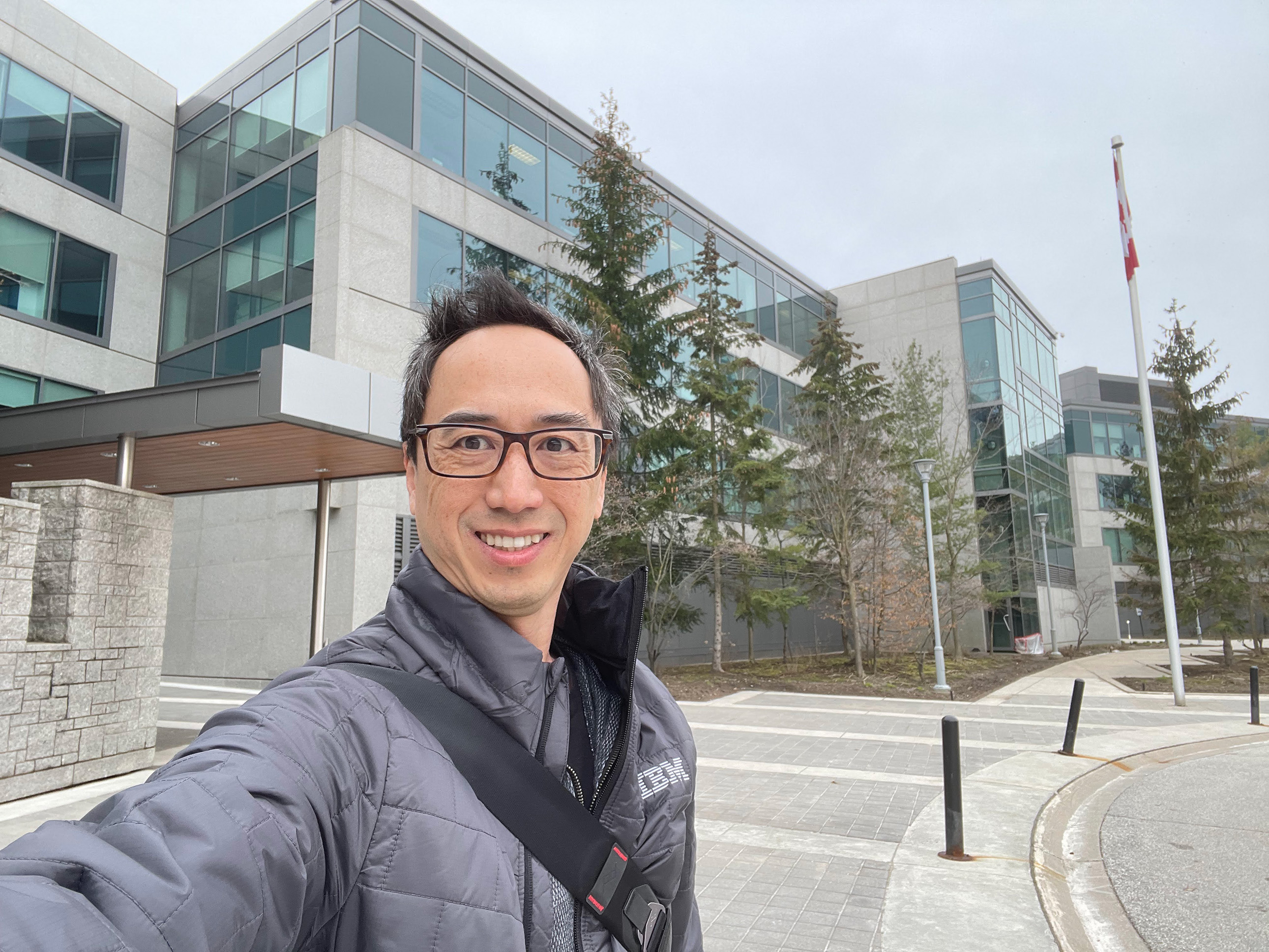
Kevin Yu
Today's Guests
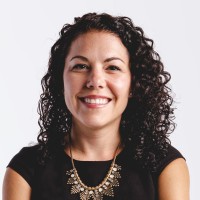
Erin Buonomo
